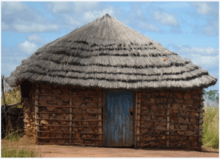Humpy
A humpy, also known as a gunyah[1][2][3][4], wurley, wurly or wurlie, is a small, temporary shelter, traditionally used by Australian Aboriginal people. These impermanent dwellings, made of branches and bark (particularly paperbark), are often built prior to the construction of more permanent buildings. They are sometimes called a lean-to, since they often rely on a standing tree for support.
.jpg)
Etymology
The word humpy comes from the Jagera language (a Murri people from Coorparoo in Brisbane); other language groups would have different names for the structure. In South Australia, such a shelter is known as a "wurley" (also spelled "wurlie"), possibly from the Kaurna language.[5][6][7]
Usage
Both names were adopted by early white settlers, and now form part of the Australian lexicon. The use of the term appears to have broadened in later usage to include any temporary building made from any available materials, including canvas, flattened metal drums, and sheets of corrugated iron.
Gallery
 Bark humpy, Brisbane, 1874
Bark humpy, Brisbane, 1874 Bushman humpy, 1910s
Bushman humpy, 1910s_(19306853893).jpg) Humpy in far western Queensland, 1937
Humpy in far western Queensland, 1937 Native Wurley, 1886
Native Wurley, 1886
Notes
- "Definition of gunyah". www.allwords.com.
- Memmott, Paul (2007), Gunyah, Goondie and Wurley : the Aboriginal architecture of Australia (1st ed.), University of Queensland Press, ISBN 978-0-7022-3245-9
- "Tents". One Planet. Retrieved 6 December 2012.
- Cannot, Jack; Prince, Victor (1912), I'll build a gunyah for you : song, Allan & Co. Pty. Ltd, retrieved 7 January 2019
- Peters, Pam, The Cambridge Australian English Style Guide, Cambridge University Press, 1996, p818
- "A Bark Humpy. How to Build it?". The Queenslander. Queensland, Australia. 30 October 1930. p. 57. Retrieved 7 January 2019 – via National Library of Australia.
- "Humpies and Gunyahs : Coloured Families on the Tweed". Sunday Mail (550). Queensland, Australia. 10 December 1933. p. 7. Retrieved 7 January 2019 – via National Library of Australia.
.svg.png)
